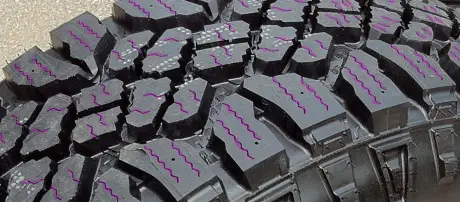
Tire siping can be easily explained in the following. When the winter months arrive, many drivers get involved in cutting some thin slits across the surface of the tire in order to improve traction, especially when they are to drive in wet or slippery conditions.
This process is also very helpful in managing the heat of the tire if the road is too hot because it can be quite a big issue during summer.
Although it is not always possible to see whether the tire has been siped or not, you can see the difference when you handle the vehicle.
What is tire siping in detail?
Tire siping is quite a simple process in which you cut the thin slits across the tire surface so that you can improve traction in snowy conditions. The process of siping is not that complicated, as the tires need to be placed on the designated machine that rotates them while making some minor 90-degree cuts in the tread.
Instead of visible inspection, feeling the improvement in vehicle handling is an easy way to tell whether the tire is siped or not.
Many experts believe that the siped tires are able to stop the vehicle much sooner; therefore, they usually recommend tire siping.
Advantages of tire siping
Better traction
There are many smaller surfaces known as tread blocks that make the surface of a tire. The importance of these surfaces increases in wet or icy road conditions because these tread blocks get their power of gripping from various surrounding edges. With the help of siping, you can get more of these gripping edges.
Improved braking
It is worth noting that an adequate power of braking happens immediately prior to losing the traction. With the help of siping, the window for the maximum braking power gets extended, and this gives a helping hand to the existing tread.
A smooth ride
A vehicle’s tire has to absorb all the impact of the surface of the road. When this surface gets rough or coarse, then the tires need to do more work. With the help of siping, your tires get micro-flexibility, and as a result, you can get a smoother ride. Therefore, it can reduce the wear on the carcass of the tire and effectively extends its life.
Long tire life
The primary cause of tire wear and failure is heat generation because it can be a natural result of friction, and too much heat can be pretty dangerous. The friction heat and its effect on your tire are reduced by siping, and in return, it helps the tire cool. These sipes isolate the heat and allow the passage of air between them, which helps to disperse this heat.
Final Verdict
When you have the basic understanding of the sipes, how the tread sipes work, and how the tire's performance is affected by them, you may ask yourself whether you should be getting a set of tires that has too much average or little to no siping.
Tire siping efficiency is a subjective question, but it is essential that you know how much you drive in rainy conditions and dry weather, and how much off-road driving is done. This affects the decision whether or not to try tire siping.
Same articles

Understanding Vehicle Inspection and Verification Services: Why They Matter for Every Driver
GuidesVehicle inspection and verification services are an essential but often overlooked part of keeping roads safe and cars legally compliant. Most people only think about inspections when it’s...
KLIFEX Brand Overview: High-Quality Automotive Repair Kits for Affordable Repairs
GuidesThe automotive aftermarket has long needed solutions that combine reliability, durability, and affordability. Many car enthusiasts and services are looking for a way...
Fast, Reliable Vehicle Emissions & Inspection Services Made Simple
GuidesFast, reliable emissions and inspection services are essential for keeping vehicles road-ready, compliant with environmental regulations, and safe for daily driving. If you’re looking for quick...

